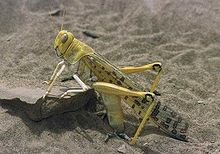MONSOON WINDS BRING HOME A VIOLENT VISITOR
Amongst the things that are happening in this current world crisis, yet another hit by nature is upon North India and neighbouring north-west countries.
WHAT ARE LOCUSTS?
Locusts are a collection of certain species of grasshoppers(short-horned) that have a swarming phase. These insects which are solitary in normal conditions become abundant and change their behaviour and habits, becoming gregarious.
 |
| A Desert Locust, source: Wikipedia |
Desert Locust is a species of locusts which are one the most devastating migratory pests in the world. Their colour changes from pink to yellow indicating their transition from immature to mature conditions. It is a highly fast-moving and feeds on very large quantity of any kind of green vegetation including crops and folder. A typical swarm is made up of 150 million locusts per square kilometre and is carried on the wind, up to 150 km in one day. Even a very small, one-square-kilometre locust swarm can eat the same amount of food in one day as about 35,000 people.
What's happening in India?
A big invasion by these desert locusts has hit a large area of India in the middle of the coronavirus pandemic. They had covered about 50,000 hectares(3/4th of a Metropolitan city like Bangalore approx.) of the desert area of western India. Rajasthan, Madhya Pradesh and Gujarat are the worst affected areas.
| Source: Locust watch by Food and Agricultural Organization of the United Nations |
The swarms flew across the Indo-Pak border around 30 April, and they are still active in five districts of Rajasthan and Madhya Pradesh. As of 26 May, at least one swarm had reached to the northeast of Bhopal. Much of these movements were associated with strong westerly winds from Cyclone Amphan in the Bay of Bengal. Control operations are underway. Several successive waves of invasions can be expected until July in Rajasthan with eastward surges across northern India as far as Bihar and Orissa followed by westward movements and a return to Rajasthan on the changing winds associated with the monsoon. These movements will cease as swarms begin to breed and become less mobile. Swarms are less likely to reach south India, Nepal, and Bangladesh.
IT'S BEEN 27 YEAR'S SINCE INDIA HAD A ATTACK LIKE THIS
In 1993 a locust swarm of a big magnitude had hit India. As per official records, the 1993 locust swarm 190 locusts swarms had attacked an area of at least 3,10,000 hectares in Jaiselmer, Barmer, Bhuj and Jalore districts of Rajasthan in 1993. Large areas in these districts again had to be treated with chemicals to get rid of locust swarms in 1997 and 2005.
HOW IS IT RELATED TO LOCKDOWN?
In the previous post, I had mentioned about the link between the lockdown and the cyclones. The cyclone has influenced the locusts to move fast and is making them much worse. So we can conclude that there is an indirect link between coronavirus and the locust swarm. But, these are all linking to one thing... HUMAN GREED FOR INFINITE GROWTH.
REFERENCE:




Locust swarms sure disrupt human lives.
ReplyDelete"150 million locusts per square kilometre" - an amazing huge number of insects. What a huge number....
They sure eat a lot of food, as well. Thanks for interesting maps.
Check out Economy and Stock Market News. Read interesting latest news about world, business, investments, marketing, advertising, funny moments and more. Take a look at Canada Forums for interesting Canadian news.